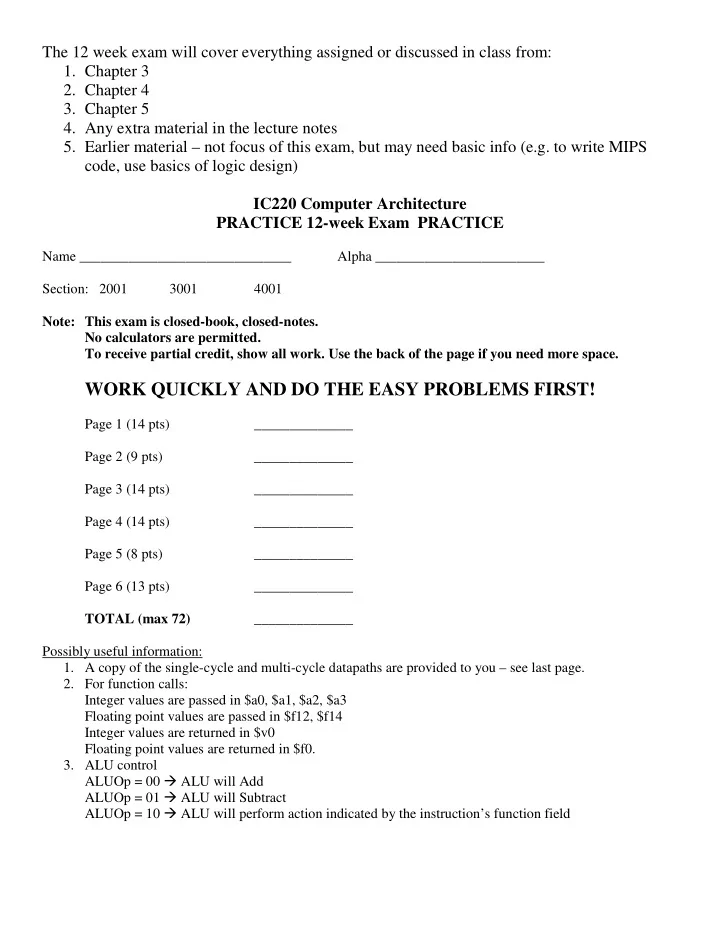

The 12 week exam will cover everything assigned or discussed in class from: 1. Chapter 3 2. Chapter 4 3. Chapter 5 4. Any extra material in the lecture notes 5. Earlier material – not focus of this exam, but may need basic info (e.g. to write MIPS code, use basics of logic design) IC220 Computer Architecture PRACTICE 12-week Exam PRACTICE Name ______________________________ Alpha ________________________ Section: 2001 3001 4001 Note: This exam is closed-book, closed-notes. No calculators are permitted. To receive partial credit, show all work. Use the back of the page if you need more space. WORK QUICKLY AND DO THE EASY PROBLEMS FIRST! Page 1 (14 pts) ______________ Page 2 (9 pts) ______________ Page 3 (14 pts) ______________ Page 4 (14 pts) ______________ Page 5 (8 pts) ______________ Page 6 (13 pts) ______________ TOTAL (max 72) ______________ Possibly useful information: 1. A copy of the single-cycle and multi-cycle datapaths are provided to you – see last page. 2. For function calls: Integer values are passed in $a0, $a1, $a2, $a3 Floating point values are passed in $f12, $f14 Integer values are returned in $v0 Floating point values are returned in $f0. 3. ALU control ALUOp = 00 � ALU will Add ALUOp = 01 � ALU will Subtract ALUOp = 10 � ALU will perform action indicated by the instruction’s function field
(3 pts) Express -5 10 as an 8-bit, two’s complement binary number. (3 pts) Add the following 4-bit binary, two’s complement numbers. (1 pts) Did overflow occur?(circle one) Yes No 1111 + 1101 (3 pts) You are given a certain 32-bit binary number. Explain how to tell if this number is one’s complement or two’s complement notation. (4 pts) Write down the “most negative” number that can be expressed using each of the following notations. Leave answers in binary form. • 6-bit two’s complement • 6-bit sign and magnitude 1
(3 pts) Convert the following 4-bit, two’s complement number to a normal base 10 (decimal) number. 1010 (6 pts) Convert +9.25 into a 32-bit floating point representation. (NOTE – this year you are NOT expected to be able to do this. But you should understand the basics of how FP numbers are represented) 2
(5 pts) Program A has the following instruction mix: 60% arithmetic instructions 30% load instructions 10% branch instructions. Arithmetic instructions take 1 cycle, loads 2 cycles, branches 3 cycles on machine P1. What is the CPI for program A on machine P1? (4 pts) Below are two examples of possible metrics for comparing performance. For each, explain clearly why using that metric is not a good idea. • The number of cycles per second (of a machine) • The number of cycles needed to execute a program (5 pts) Suppose a program runs in 50 seconds on a machine, with division operations responsible for 30 seconds of this time. To achieve a speedup of 2.0, how much faster must division be made to operate? Use Amdahl's Law. 3
The questions on this page all refer to the Single-Cycle Datapath (see attached figure) (8 pts) Provide the requested control signals for the following instruction. Show don’t cares if appropriate. lw $t0, 4($s3) RegDst = Branch = MemRead = MemWrite = ALUSrc = RegWrite = MemtoReg = ALUOp = (6 pts) In the homework we discussed “stuck-at-0” faults. Signals may also be “stuck-at-1”. Consider each of the following faults below. For each, explain which, if any, instructions will not work properly and (briefly) why (correct reason required for credit). Consider the following instructions: add, sub, lw, sw, beq. Assume the following latencies: a.) RegDst stuck-at-1 b.) ALUSrc stuck-at-0 (NOT 1) c.) RegWrite stuck-at-1 4
The questions on this page all refer to the Single-Cycle Datapath (see attached figure) (4 pts) Consider the sign-extend unit located just below the register file. Suppose an error caused this unit to always think that the input 16-bit number had a “0” in the MSB, and thus it always treated that number as positive. Explain what instructions, if any, would no longer work properly and under what circumstances. Consider add, sub, lw, sw, and beq. (4 pts) Compared to the multi-cycle implementation… a.) What is one advantage of the single-cycle implementation? b.) What is one disadvantage of the single-cycle implementation? 5
The questions on this page all refer to the Multi-Cycle Datapath (see attached figure) (6 pts) Here is an RTL sequence for some instruction: IR <= Memory[PC] A <= Reg[IR[25-21]] B <= Reg[IR[20-16]] ALUOut <= A + sign-extend(IR[15-0]) Memory[ALUOut] = B PC <= PC + 4; a. (2 pts) What instruction is this? b. (3 pts) Given the standard assumptions we made in class about how much can de done in a single cycle, label each of the above 6 RTL statements with the cycle number (starting from 1) during which it could first execute. c. (1 pt) How many cycles overall are needed for this instruction? (7 pts) Consider the “beq” instruction as discussed in class. This instruction completes during its third cycle of execution. During this cycle, it updates the PC to a previously computed branch target address if the branch condition is true. Show the control signals needed to make this happen. Show don’t cares where appropriate. PCWriteCond = PCWrite = IorD = MemRead = MemWrite = MemtoReg = IRWrite = PCSource = ALUOp = ALUSrcA = ALUSrcB = RegWrite = RegDst = 6
Recommend
More recommend